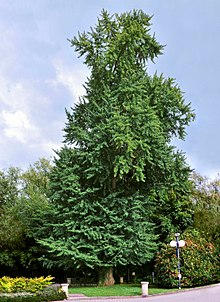Ginko biloba
|
Ginkgo biloba Temporal range: 51.5–0 Ma Eocene - present@ |
|
|---|---|
 |
|
| Mature tree | |
| Scientific classification | |
| Kingdom: | Plantae |
| Division: | Ginkgophyta |
| Class: | Ginkgoopsida |
| Order: | Ginkgoales |
| Family: | Ginkgoaceae |
| Genus: | Ginkgo |
| Species: | G. biloba |
| Binomial name | |
|
Ginkgo biloba L. |
|
| Synonyms | |
|
|
Ginkgo biloba, commonly known as ginkgo or gingko (both pronounced /ˈɡɪŋkoʊ/), also known as the ginkgo tree or the maidenhair tree, is the only living species in the division Ginkgophyta, all others being extinct. It is found in fossils dating back 270 million years. Native to China, the tree is widely cultivated and was introduced early to human history. It has various uses in traditional medicine and as a source of food. The genus name Ginkgo is regarded as a misspelling of the Japanese gin kyo, "silver apricot".
The species was initially described by Carl Linnaeus in 1771, the specific epithet biloba derived from the Latin bis, "two" and loba, "lobed", referring to the shape of the leaves. Two names for the species recognise the botanist Richard Salisbury, a placement by Nelson as Pterophyllus salisburiensis and the earlier Salisburia adiantifolia proposed by James Edward Smith. The epithet of the latter may have been intended to denote a characteristic resembling Adiantum, the genus of maidenhair ferns.
The relationship of ginkgo to other plant groups remains uncertain. It has been placed loosely in the divisions Spermatophyta and Pinophyta, but no consensus has been reached. Since its seeds are not protected by an ovary wall, it can morphologically be considered a gymnosperm. The apricot-like structures produced by female ginkgo trees are technically not fruits, but are seeds that have a shell consisting of a soft and fleshy section (the sarcotesta), and a hard section (the sclerotesta). The sarcotesta has a strong smell that most people find unpleasant.
...
Wikipedia

